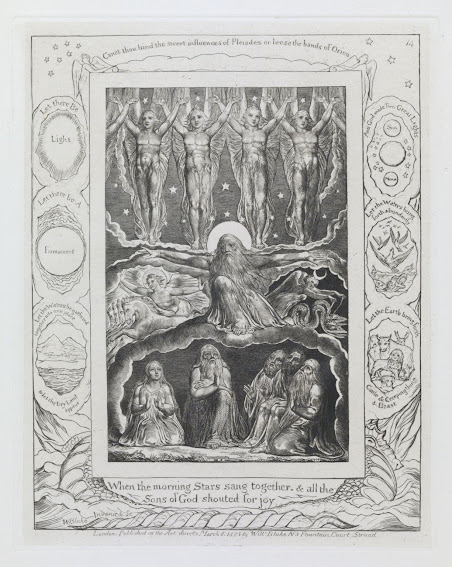Art Analysis Blog
This is the work of William Blake (1757-1827). In 1828, he began his book of line drawings depicting the Book of Job. I could not find information on where these were drawn, it is likely unknown. These drawings were full of prime examples of tone, shape, and mood. This particular piece, "When the Morning Stars Sang Together", shows different elements of the story as parts of a whole. They are separated by Blake's representation of God.
At the bottom, you see Job, his wife, and their three friends looking upwards. There is strong contrast seen here. The background is very dark, which highlights the focus that is the faces of the five people. They are surrounded by what seems to be a cloud. This cloud has soft curves, as do all elements of this are of the work. These are organic shapes that help to give the feeling of peace (this work depicts the resolution of the story).
When I look at the depiction of God, I see that he has his arms outstretched. This makes it feel as if He is embracing everything. He is central, singular, and also part of all parts of the story, each represented in a distinctly different area on the image. The white circle that is behind His head also draws attention, as it is the lightest value in the drawing. It helps to define the importance of the central element of the work.
On the right, you see the devil, and the left shows angels. These two sub-images contrast greatly with each other. The powers of evil are shown with a lot of dark value, while the powers of good are shown with light values. This helps the viewer (even if they do not know the story) see that they are opposing forces.
The top of image is as important as all of the others. It has a lot of the elements of art. I see upright lines (the outlines of the angels) and negative space (the starry backdrop). A viewer also sees the repetition of the basic form of the angels.
As for placement of the piece, it is an art plate from a book. This is not a piece of wall art, but a finely-crafted line drawing meant to be protected with a sheet of tissues paper in a volume with the rest of its counterpart works. Together they both show the skill of their artist, and depict a classic biblical story.
Sources and additional information:
more about this art
information about the artist
“William Blake.” Wikipedia, Wikimedia Foundation, 6 May 2024, en.wikipedia.org/wiki/William_Blake.



Hello Jack,
ReplyDeleteTo begin with, you chose a remarkable piece and your excellent breakdown of it was insightful. This kind of art seems strange and eccentric at first glance but after learning the tie to the Book of Job my understanding of the piece grew. The classic battle between good and evil is both on full display and is wonderfully portrayed throughout this painting. As I’ve stated before in my own blog posts, I love reading and as such one of my favorite parts of this work was the inclusion of the script. The phrase “loose the bands of Orion” was particularly powerful to me. This kind of “religious art” is obviously a strong suite of Mr. Blake. This piece normally wouldn’t be in my wheelhouse, but now I'm wondering why not? Thanks for sharing!
Vaughan
Hi Jack,
ReplyDeleteThank you for the great summary of this piece. I had a different first impression, but the description you provided is very enlightening. The use of form is strong here. The outstretched arms seem to be holding the stars up. Also, the hands of God here are simultaneously downturned over the angels and upturned over the devil. I wonder if there is significance in that. There is definitely a use of tone as well. It seems to transition from light to dark as we move from top to bottom. The use of shape for the crowns of God and the Angels is circular and suggestive of good vs evil when compared to the sharp crescent of the devil as well. Thank you for sharing.
Somehow I didn't see the devil and the angels sub-art, great job pointing that out! I love the use of light/dark in this image, the contrast always makes things pop and evokes emotion. When searching for art for my analysis, I also found most pieces I was drawn to were also based on religion. I love this because you really get to see a different perspective than your own!
ReplyDelete